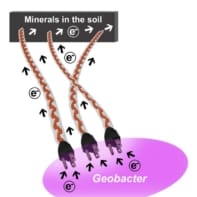
A trilayer graphene (TLG) and hexagonal boron nitride (hBN) moiré superlattice could be the ideal platform in which to study strong correlated physics and so find signatures of high-temperature superconductivity. So say researchers at the Lawrence Berkeley National Laboratory and the University of California at Berkeley who have observed metal-to-Mott insulator and Mott insulator-to-superconductor phase transitions as a function of electron-electron correlation strength in the 2D heterostructure material.
In recent years, researchers have been able to exfoliate and stack atomically thin 2D materials to make synthetic quantum materials, such as new classes of van der Waals heterostructures. They can conveniently control the quantum mechanical interactions between large numbers of electrons in these materials, and thus their electronic properties, by changing both the composition and the direction in which the different layered materials are stacked and by applying an external electric field via electrostatic gate contacts.
Such techniques have led to the recent discovery of correlated insulating states and superconductivity in so-called magic-angle twisted bilayer graphene (TBG) and gate-tuneable Mott insulating states in ABC-TLG-hBN heterostructures.
Hubbard model
Understanding high-transition-temperature (high-Tc) superconductivity, which occurs when electrons overcome their mutual electrical repulsion and form correlated “Cooper pairs” that then travel unheeded through the material as a supercurrent, is an important goal in condensed matter physics. One system in which this superconductivity is predicted to appear is a doped Mott insulator as described by the Hubbard model, which defines electrons as Fermi-Dirac particles (fermions) that hop between fixed sites on a lattice. These electrons only interact with each other when they occupy the same lattice site. The researchers, led by Feng Wang, thus decided to investigate ABC-TLG-hBN heterostructures since they are thought to be the ideal platform in which to study this model.
The researchers made their heterostructures by stacking exfoliated ABC-TLG and hBN in a hBN/ABC-TLG/hBN sandwich using a dry transfer technique. They assembled the stacks by carefully aligning them at a certain angle and then fabricated electronic devices from them in a Hall bar geometry. They contacted the TLG through 1D edge contacts with non-superconducting Cr/Au metals and then deposited a metal top electrode to form dual-gated devices. This arrangement means that the structures can be gated via both the top metal electrode and a bottom silicon substrate.

”
“This dual-gate configuration allows us to control the electron concentration and mini-bandwidth of the ABC-TLG/hBN heterostructure independently by applying a vertical electric field, D,” explains study lead author Guorui Chen. “This means we can control the electron-electron interactions in a single device and so see the phase transition from metal-to-Mott insulator and Mott insulator-to-superconductor as a function of the electron-electron correlation strength.”
“Domes” in the phase diagram
The researchers performed their experiments at “relatively” high temperatures of 5 K and observed one-quarter and one-half Mott insulating phases in the phase diagram of the material. These correspond to one and two holes per unit cell respectively. They then cooled the sample down to 40 mK and observed signatures of superconductivity (“domes” in the phase diagram) when a very large vertical electric field of -0.54 V/nm was applied to the one-quarter filling Mott state doped with electrons.
“Since we have two parameters (carrier doping, n, and vertical electric field, D), we spent a lot of time searching for the parameter space in which superconductivity should appear because we didn’t know where this was,” Chen tells Physics World.
This heterostructure is very different to “magic angle” TBG (an experimental platform engineered on two misaligned graphene layers – at “magic angles” near 1.1° so that they form a moiré pattern),” says Chen. “When we started our project in February 2017, we hadn’t heard of magic angle TBG yet.”

Several advantages
“Compared to this material our TLG has several advantages. First, we can tune the correlation strength in the material, or its bandwidth, by tuning the vertical electrical field applied to it. Second, the moiré pattern of TLG is more uniform than that of TBG’s. Third, the TLG/hBN is not so twisted-angle sensitive compared to TBG, which only works at one magic angle. For TLGs, any small angle close to zero is fine. And finally, TLG/hBN offers a more general route to obtain 2D correlated systems.”
The researchers say that the electronic behaviour in the ABC-TLG/hBN superlattice should depend sensitively on the interplay between the electron-electron interactions and the mini-bandwidth. “The electron-electron interaction strength is described by U/t, where U is the Coulomb energy of these interactions and t is the carrier hopping term – which is proportional to the bandwidth for a solid,” explains Chen. “We thus know that we need to reduce the bandwidth to enhance the electron-electron interactions.”

‘Magic-angle graphene’ behaves like a high-temperature superconductor
Follow-up studies
The team is now busy with follow-up studies to understand the mechanism behind superconductivity in ABC-TLG/hBN. “For example, scanning tunnelling microscopy studies could provide us with more information on the correlated phases present,” says Chen. “We are also making higher quality samples to increase the superconducting Tc of the material. Its magnetic properties are also very important and magnetotransport or direct magnetic susceptibility measurements could be helpful to us here.”
Chen says that he and his colleagues are also particularly interested in the topological properties of ABC-TLG/hBN. “So far we have observed ferromagnetism with a quantized anomalous Hall effect in the material as a Chern insulator phase with a Chern number of two. This is, as far as we know, the first such system with a Chern number of greater than one. We have published these results on arXiv and are very excited to find superconductivity and topological phenomena in a single material.”
The research is detailed in Nature 10.1038/s41586-019-1393-y.



